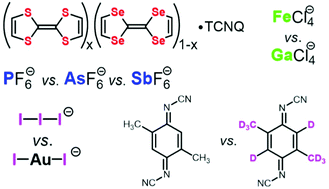Solid-solution (alloying) strategies in crystalline molecular conductors
Abstract
In this review, we describe solid solution strategies employed in molecular conductors, where the control of their transport and magnetic properties (metallic or superconducting behavior, metal–insulator transitions, etc.) is the main goal. We first describe the main features of molecular conductors in order to identify which molecular entities are prone to be substituted by others in solid solutions, to which extent and for what purpose. We then describe the different crystal growth techniques used toward solid solution preparation and the nature of the molecular species, whether electroactive or not, which have been used, in cation or anion radical salts, in charge transfer salts and in single component conductors, in more than sixty reported examples. Topics such as preferential insertion and miscibility, the nature of disorder and the different analytical tools used for characterizing these alloys are presented. The consequences of alloying on conductivity and on phase transitions (superconductivity, anion ordering, Peierls transition, spin-Peierls transition), and the concepts of chemical pressure effects, band filling manipulation, and π–d interactions with magnetic anions are also discussed.

- This article is part of the themed collection: Materials for molecular electronics and magnetism


 Please wait while we load your content...
Please wait while we load your content...